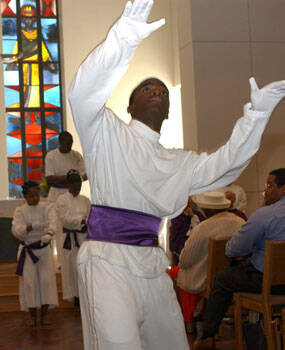It was a fine spring morning in a forest near Ottawa. The early flowers were just beginning to show themselves through the still-wintry earth. I had a day to myself and intended to begin it with a leisurely, contemplative stroll through the woods.
I did not know then that on the other side of the Atlantic, a lady I had never met was feeling far from spring-like. She had been a liturgical dancer. She loved her ministry, and others seemed to find it helpful too. Then a change of personnel at her parish church had brought an abrupt end to it. “No dancing in church!” the new incumbent had decreed. And there was little she could do about it. She got on with her life and tried to forget her dancing.
I wandered along the winding pathway, stopping to admire the trilliums, flowers that do not grow in my own native land, and then I noticed something strange. A dead, brown, withered leaf from last year’s fall was floating in the breeze, just at eye level. I stopped to investigate, asking myself why it didn’t either fly away on the breeze or fall to the earth, as one expects dead leaves to do. Even on closer inspection I couldn’t see any reason for its behavior. No sign of anything connecting it to the nearby tree. Nothing.
So I continued my walk and almost forgot about the dancing leaf, until over an hour later I returned by the same route, and there was the leaf again, still dancing in front of my eyes, as if to greet me with a playful twinkle: “Here I am. Catch me if you can.” This time I was determined to get to the bottom of the matter. And sure enough, when I looked more closely, I did find a thin, gossamer-like thread, barely visible, which was holding the leaf securely connected to a nearby branch. Mystery solved.
Yet strangely, the incident of the dancing leaf kept coming back to my mind. I found myself reflecting on that gossamer thread. If the leaf had not been connected by that thread, it would certainly have flown off in the wind and eventually fallen to the ground. The connection was a vital one. But if that gossamer thread had been a rod of steel, the leaf would have remained connected—but it would not have danced.
This whole incident never really left me. Some considerable time later I was facilitating a retreat in Scotland, and I happened to tell the participants the story of the dancing leaf. We connected it with Jesus’ parable of the vine, and of the importance of staying connected to the true vine, while knowing that the true vine continually invites us into the freedom of the dance.
The days passed, and on the last morning we all gathered in the little chapel to break bread together and share the Eucharist. We had journeyed together for a few days and we felt closely bonded. After Communion a joyful surprise broke out. One of the retreatants felt moved to dance. We were spellbound. The beauty, the grace and the power of her dance left us all speechless and deeply blessed. Afterward we expressed our gratitude, and only then did she share something of her story: the story of how six years earlier she had been told to stop dancing; how she had resigned herself to never performing sacred dance again; how the rod that connected her to the vine had turned to steel.
Her rod turned back to gossamer that morning, and she is more connected than ever now to the true vine in which she lives, and dances and has her being. Through her ministry others also discover the joy and the life that flows through that connectedness.
What threads connect us to each other? And are they liberating or paralyzing? I remember a moment in my own childhood when a paralysis set in for me too. I used to sing myself to sleep regularly as a small child. Then one evening, in mid-song, a parental voice called up to my bedroom: “Stop treading on that cat’s tail.” I stopped, instantly. I have never been able to sing in public again. Not that this is any loss to the world at all, but it does remind me of how easy it is to turn the threads of relationship into rods of steel. When we do this, however well-meaningly, we can freeze the life in each other and turn it to stone. This tendency to paralyze each other can be hereditary too. The parent who silenced my song that night had also been held by rigid reins of convention and control, as I was later to discover. We can only speak the language that we learn, usually in childhood. What language have I taught my own child? Have I given her the freedom to dance, while holding her close in loving connectedness?
When a ship drops anchor, the length of the anchor chain must be at least three times the depth of the sea at that point at high tide. Imagine what would happen to a ship moored at anchor with an anchor chain equal only to the depth of the ocean at low tide. What happens when the tide rises is not too hard to figure out. The danger of a leash that is too short and a connection that is too rigid is as great as the danger of not being connected at all.
Finding the balance between loving connection and stifling control is a challenge to us all—partners, parents, pastors and politicians alike. But we have a model of how to get it right. He is the one who knows that when you are truly connected to the source of your being, you can dance freely and joyfully into the future, even in the shadow of a cross.








